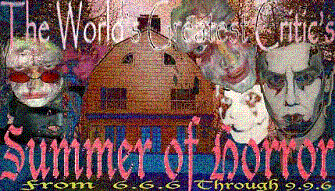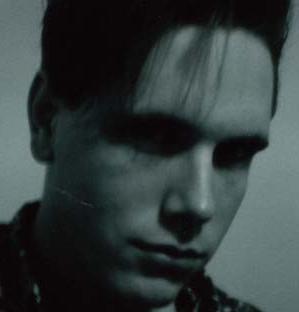Nosferatu is a name synonymous with horror since Bram Stoker brought it to the public vocabulary with his best known novel Dracula. In 1922, with the classic German Dracula adaptation Nosferatu, eine Symphonie des Grauens, the name "Nosferatu" became irreversibly linked to one character, that of Max Schreck's nightmare depiction of our famous Transylvanian Count. Of course, having failed to legally obtain the rights to Dracula from Stoker's Estate, director F.W. Murnau had to rename his Nosferatu Character from Count Dracula to Graf Orlok. Regardless, it's still considered by many to be the definitive film representation of Dracula!

|

Part of the 2006 Summer of Horror!





|
Over half-a-century later, noted experimental director Werner Herzog (who was born twenty two years after the original was released) brought his own version of Nosferatu to the screen. While nominally (essentially) a remake of Murnau's film, Herzog restores the names of the characters (including the count's to Dracula) and takes a number of cues from other adaptations of Stoker's masterpiece.
Further, to keep up with the groundbreaking nature of the original Nosferatu, Herzog brigs forth his own surreal sensibilities to the project, both writing and directing a strange, almost dream-like Dracula tale that evokes almost as many nightmares as the original.
Klaus Kinski stars as our titular Vampire (or "Vampyre") with a make-up and mood clearly inspired by Max Schreck. The horrible, frightening and monstrous aspects of Dracula are restored in his performance, sacrificing the canonically questionable romantic elements of the creature's make up. In fact he ultimately less resembles Lugosi or Lee than he does Colonel Klink. However, Kinski's Dracula isn't purely the emaciated demon with Spock ears he initially may appear to be. Here Dracula is a tortured soul, seeming to resent both his vampiric appetites and his eternal life as symptoms of a curse.
Although Herzog (like almost every adapter of Stoker's work) takes some singular liberties with his source material, combining and reversing the Mina and Lucy characters, and twisting certain plot lines to his own ends, the basic story will seem familiar to any and everyone who has watched a Dracula film before. Poor Mr. Renfield (Roland Topor) shows his psychosis early here, but still manages to find the wherewithal to send old Jonathan "Chuckles" Harker (Bruno Ganz) to Transylvania to finalize the most filmed Real Estate Deal in the history of the world. This is much to the chagrin of John-boy's beautiful wife "Lucy" Harker (Isabelle Adjani, depressingly never nude).
Herzog's imagination shines through almost immediately after the familiar opening. Villager fear of the Count forces Harker to actually walk across the Carpathians. Herzog allows his camera to tell the story in a detailed and entrancing slideshow of scenery along this journey. Once Harker arrives at the Count's Castle, the surreal nightmare gets even deeper. Johnny's more familiar ordeals are enhanced by the strange comings and goings of people and things who have no real anchor to the Palace or, possibly, to reality. While Herzog dispenses with the "Brides of Dracula", he does take an interesting approach to the "Seduction of Mina". Here Lucy (who, for the most part, represents both the textual Mina and Lucy characters) seems to be tormented by Dracula long before his journey from Transylvania. Her connection to Jonathan causes her to share his nightmare and torment, even as the Count himself proves to be equally as tortured and lost.
Dracula's journey and arrival at his new home ("Carfax Abbey" is now in Bismarque instead of England) mirrors the Murnau version, yet enhances the suggestive themes to a greater extent. The plague that accompanies Dracula is given front burner treatment and Herzog plays with Murnau's use of Shadow to great results. However, although Herzog's camera eye is still at its artistic best, the second half of his Nosferatu becomes a bit of a mixed bag. In his commitment to a silent movie style, Herzog's actors manage to come off as melodramatic and overly expressive. Occasionally even Dracula comes off as unintentionally funny. Renfield in particular is less the creepy psychopath than the annoying laughing boy sitting behind you in the theatre.
Still, Herzog manages to provoke some fascinating questions. For example, if Dracula is moving to an Abbey, wouldn't there be plenty of Crucifixes still around? Guess so. As the plague takes hold (there are more rats in this movie than bricks, I'd wager) the village becomes a psychotic playground of the celebrating dead. It's a motif that Herzog milks to great success, especially as Adjani's Lucy appears to be the only sane and safe person in a village of the dying victims. Not even Dr. Van Helsing (Walter Ladengast), who ought to freaking know better, believes her for a split second.
From that point Dracula's all "BOO!" and Jonathan's all "Hiss!" and Lucy's all "EEK! Oh, WAIT, HMMMMMM!" and Renfield's all "He-He!" and the villagers are all "Ack, I'm dead!" and the rats are all "squeak, squeak, we're evil!" and Van Helsing's all "WHAAAAAAAAAAA?" and nobody ever bothers to say "LUCY, YOU GOT SOME 'SPLAINING TO DO!"
It all leads up to a mixed ending, part Stoker, part Browning, part Murnau and all Herzog. It may or may not be your cup of tea, depending on your taste. The same can be said for most of the rest of the feature, as good as it is. Nosferatu is always beautiful and always entertaining. However, there are some moments of side characters showing some decidedly Spaghetti Western style dubbing. While the actors are fantastic, universally, there are a few too many moments of melodrama and ticklish blocking. Dracula's rebuke of Renfield is borderline hysterical. Further, literary purists might take issues with a few of the liberties Herzog takes.
Regardless of this, however, Herzog is an incredible artist with the camera. His use of buildings as gothic characters in and of themselves is incredible. His use of color along with the tasteful balance of light and shadow is a must for any aspiring film maker to see. The final shot is worth the entire viewing. The fact that it's all natural and all captured perfectly as if Herzog reached into a dream and slapped it onto the silver screen is all the more breathtaking. This, of course, is a credit not just to Herzog himself, but to Cinematographer Jörg Schmidt-Reitwein.
To be sure, Nosferatu - fantôme de la nuit is among the best Vampire movies ever made, and fully worth its legacy and title. It's an expressionistic art film that never forgets that Horror is Horror and that being a Monster is Monstrous. The psychology of the Vampire as well as the frights of night and the ravages of disease come together to form a fascinating dreamscape. If only the entire film shared this cohesion. Three and One Half Stars out of Five for Nosferatu the Vampyre (one of a few names of this classic). It might not be the original, but it's more than worth the time of any fan of Dracula or Vampire Lore. So until Mattei's Rats is remade with the underground town being infested with Vampires, I'll see your bald, Vulcan, plague-carrying, blood-sucking, bat-morphing nightmare self in the next Transylvanian reel.


 1/2
1/2

